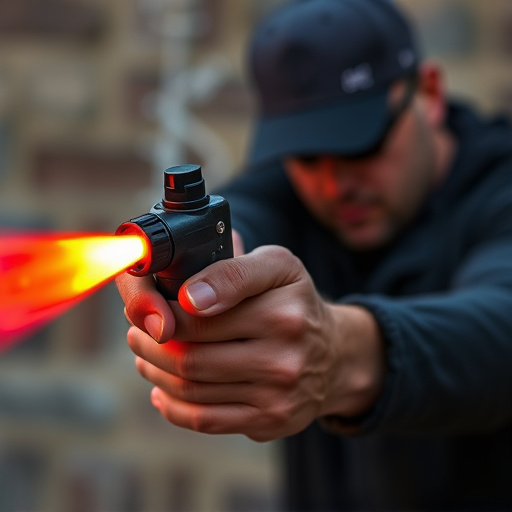Storing pepper spray correctly (in cool, dry conditions, away from sunlight and extreme temps, in airtight containers) maximizes its effectiveness, extends lifespan, and ensures safety. Regularly check expiration dates and follow strict disposal guidelines to maintain optimal performance when needed most for public safety.
“Uncover the power and intricacies of police-grade inflammatory pepper spray, a versatile tool in law enforcement. This comprehensive guide explores its composition and effectiveness, shedding light on why understanding its chemistry is key. We delve into best practices for storing pepper spray to maintain maximum effectiveness, as well as factors influencing its longevity.
Additionally, discover essential safety measures and disposal guidelines for used pepper spray, ensuring responsible handling.”
- Understanding Pepper Spray Composition and Effectiveness
- Best Practices for Storing Police-Grade Inflammatory Pepper Spray
- Factors Affecting the Longevity of Pepper Spray
- Safety Measures and Disposal Guidelines for Used Pepper Spray
Understanding Pepper Spray Composition and Effectiveness
Pepper spray, a powerful tool used by law enforcement and self-defense enthusiasts alike, is composed of capsaicin, the same compound that gives chili peppers their heat. This chemical irritates the eyes, nose, and throat, causing temporary blindness, difficulty breathing, and intense pain. However, understanding its composition alone isn’t enough to ensure maximum effectiveness; proper storing plays a pivotal role.
Storing pepper spray correctly maintains its potency and ensures it’s ready when needed. Ideally, keep it in a cool, dry place away from direct sunlight or extreme temperatures. Many manufacturers recommend storing it in a pouch or container designed for optimal preservation, often featuring air-tight seals to protect against moisture and degradation. Additionally, checking the expiration date regularly is crucial, as pepper spray can lose its potency over time, underlining the importance of proper storage for maintaining its effectiveness.
Best Practices for Storing Police-Grade Inflammatory Pepper Spray
When storing police-grade inflammatory pepper spray, it’s crucial to follow best practices to ensure maximum effectiveness and longevity. Keep the spray in a cool, dry place away from direct sunlight or extreme temperatures, as heat can degrade its potency. A locked storage cabinet or safe is ideal to prevent unauthorized access. Additionally, store it separately from other chemicals or substances that could interact with its components.
Regular maintenance is key. Periodically check expiration dates and test the spray’s functionality to ensure it remains potent. Proper storage conditions and routine checks will help maintain the spray’s strength, ensuring it’s ready for use when needed. This proactive approach maximizes the effectiveness of police-grade inflammatory pepper spray, a critical tool in public safety and security.
Factors Affecting the Longevity of Pepper Spray
The longevity of pepper spray effectiveness is influenced by several key factors. One of the primary considerations is storing Pepper Spray for Maximum Effectiveness. Proper storage conditions, including temperature and humidity control, are essential to maintaining its potency. Extreme heat or direct sunlight can degrade the active compounds, so storing it in a cool, dry place is crucial. Many manufacturers recommend keeping pepper spray in temperatures below 75°F (24°C) and relative humidity levels between 40-60%.
Additionally, exposure to air and moisture can impact the spray’s performance. It’s important to keep the canister sealed tightly to prevent oxygen from reaching the active ingredients, which can reduce their effectiveness over time. Proper storage practices, combined with regular rotation of stock to use older cans first, will ensure that pepper spray maintains its intended potency when needed most.
Safety Measures and Disposal Guidelines for Used Pepper Spray
After use, storing pepper spray properly is paramount to maintaining its effectiveness and safety. It’s crucial to keep it in a cool, dry place away from direct sunlight or heat sources. Extreme temperatures can degrade the active ingredients, reducing the spray’s potency over time. A locked cabinet or secure container is ideal for storage, ensuring only authorized individuals have access. This prevents accidental discharge and keeps the spray out of the reach of children or untrained hands.
Disposal guidelines are essential to follow as well. Pepper spray should never be disposed of down the drain or in regular trash because it can still pose a risk to water sources and the environment. Check local regulations for proper disposal methods, but many areas recommend specialized hazardous waste facilities. Never pour used pepper spray into a toilet or sink, as this could contaminate water systems. Following these simple steps ensures the safe handling of used pepper spray, minimizing potential risks while maintaining its intended purpose for future use.
Police-grade inflammatory pepper spray is a powerful tool, but its effectiveness and safety depend on proper storage and disposal. By understanding the composition, best practices for storing, factors affecting longevity, and safety measures outlined in this article, you can ensure that your pepper spray remains potent and is used responsibly, contributing to maximum effectiveness in emergency or self-defense situations.
